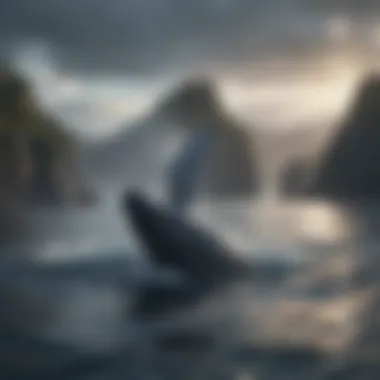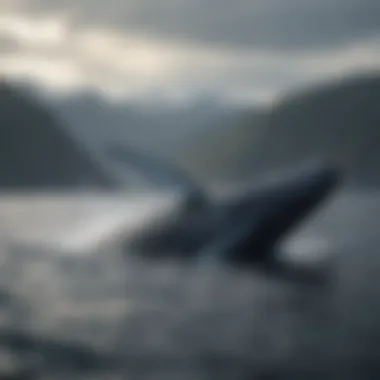Global Whale Population Status: Current Insights


Intro
Whales represent a crucial element of the marine ecosystem. Their populations across the globe are indicative of the overall health of oceanic environments. Understanding the current status of these populations requires intricate exploration. Various species, each with distinct characteristics and needs, face differing threats. This analysis aims to dissect the complex dynamics surrounding whale populations, investigating the past, present, and future of these majestic creatures.
Methodologies
Description of Research Techniques
Research on whale populations typically employs a mixture of direct observation and remote sensing techniques. Aerial surveys help in estimating population numbers and distribution. Such surveys allow scientists to cover vast areas of ocean quickly. Underwater acoustic monitoring plays a significant role as well, as it captures vocalizations from various whale species. This method provides insights into their behavior, social structures, and migration patterns.
Tools and Technologies Used
To obtain accurate data, researchers harness advanced technologies. Satellite tracking devices are pivotal in monitoring the movements of tagged whales. These devices help scientists understand migration routes and habitat use. Furthermore, genetic analysis is becoming more essential in conservation initiatives. Understanding genetic diversity aids in efforts to mitigate inbreeding and bolster population resilience.
- Aerial Surveys: Quick coverage of ocean expanses.
- Underwater Acoustic Monitoring: Reveals vocal behaviors and social interactions.
- Satellite Tracking: Tracks movements and migration patterns.
- Genetic Analysis: Enhances understanding of biodiversity.
Discussion
Comparison with Previous Research
The study of whale populations has evolved significantly over the past few decades. Previous studies often relied solely on sighting data, which presented an incomplete picture of whale dynamics. The integration of technology, such as satellite tracking, provides a more comprehensive understanding. Recent investigations suggest a decline in certain populations, emphasizing the need for adaptive conservation strategies.
Theoretical Implications
The data gathered opens discussions on the broader implications of human impact on marine life. It raises questions about ecological balance and the role of marine mammals in nutrient cycling and marine health. The complex interrelations between whale populations and other marine species become increasingly evident with research advancements.
Foreword to Whale Populations
Understanding whale populations is crucial for several reasons. First, these majestic marine mammals are integral to ocean ecosystems. They aid in nutrient cycling and impact the health of marine food webs. Their presence helps maintain biodiversity, which is vital for ecosystem stability.
Whales also serve as indicators of marine health. Their population dynamics reflect the overall condition of the oceanic environment, helping scientists monitor changes and assess the impact of human activities. Therefore, studying these populations can reveal important insights into ocean climate and health.
Moreover, many whale species face significant threats from various human activities. By examining whale populations, we can identify these threats and develop strategies to mitigate them. This research is not only relevant to conservation efforts but also to local communities that depend on marine resources for their livelihood.
Global Whale Population Estimates
Current Population Numbers
Estimating the population of whale species is a complex task. The numbers can vary broadly based on species and region. For instance, the Humpback Whale, a recovering species, shows estimates of around 80,000 individuals. This is a marked improvement from historic lows during commercial whaling.
Other whale species present a different picture. The Blue Whale, the largest animal on the planet, has an estimated global population of about 10,000 to 25,000. The Gray Whale population is more stable, estimated at around 27,000, although certain populations, such as the Western Gray Whale, face critical threats.
Factors influencing these numbers include mating patterns, feeding grounds, and human impacts. It's also important to recognize that these figures are continually being updated as new research emerges. Accurate data collection is imperative for understanding overall trends and crafting effective conservation measures.
Population Trends Over Time
Over time, whale populations have undergone significant fluctuations due to a variety of causes. Historically, commercial whaling wreaked havoc, leading to extreme declines in many species. The Sperm Whale, for example, was heavily targeted for its valuable oil, resulting in a drastic decrease in its population.
In recent decades, however, there are signs of recovery for some species. The concerted efforts of conservation initiatives have led to a gradual rebound in populations. \nYet, it is crucial to note that the recovery is not uniform. For instance, while some populations of Humpback Whales are now robust, others, such as the North Atlantic Right Whale, remain incredibly vulnerable, with an estimated population of fewer than 350 individuals.
The trends can also be influenced by environmental changes. Factors such as shifting prey availability due to climate change, ocean temperatures, and habitat loss all pose new challenges. Monitoring populations over time helps in understanding these dynamics, allowing for more targeted conservation strategies.
"Monitoring and understanding the status of whale populations is essential for future conservation efforts and global marine health."
Overall, analyzing population trends not only informs conservation tactics but also engages stakeholders across the globe in meaningful dialogue. Respect for these creatures is rooted in clear knowledge of their current standing. As research continues, updating these population estimates remains crucial for ongoing efforts to protect whales.
Key Species and Their Status


The examination of whale populations cannot conclude without recognizing the key species and their individual contributions to marine ecosystems. Understanding these species helps in grasping the various dynamics at play in their populations. Each whale species plays a unique role in the ocean's health, from nutrient cycling to maintaining the structure of marine habitats.
Baleen Whales
Humpback Whale
The Humpback Whale is known for its acrobatic behavior and long migrations. Its role in nutrient transfer through its feeding habits is important for ocean health. One key characteristic of Humpback Whales is their melodious songs, which serve various purposes including communication and possibly attracting mates. This distinctive attribute makes them an interesting subject of study. However, they face challenges related to their migratory patterns, such as ship strikes and climate-related changes in their feeding grounds.
Blue Whale
The largest animal on the planet, the Blue Whale, is essential in sustaining oceanic food webs. It primarily feeds on krill, and its massive size allows for significant energy transfer through the ecosystem. The Blue Whale's ability to consume vast amounts of small prey is one of its defining features. This makes its conservation critical, as a decline in populations can disrupt the broader marine ecosystem. However, its immense size also poses disadvantages when considering threats such as entanglement in fishing gear and ship collisions.
Gray Whale
Gray Whales are known for their long migrations along the Pacific coast. Their key role in nutrient cycling enhances the productivity of coastal ecosystems. One significant characteristic is their bottom-feeding behavior, which stirs up the ocean floor and provides nutrients to other marine life. This unique feature positively impacts the marine ecosystem; nonetheless, they are vulnerable to habitat loss and are affected by increasing ocean noise due to human activities.
Toothed Whales
Sperm Whale
Sperm Whales are renowned for their deep diving capabilities, allowing them to hunt for squid at substantial depths. Their social structures and communication techniques, including clicking sounds, make them extraordinary creatures. Highlighting the intelligence of Sperm Whales is important; they exhibit complex social behaviors and strong familial bonds. However, they are exposed to threats from whaling practices and ocean pollution, which disrupt their habitats and feeding patterns.
Orcas
Orcas, or killer whales, exhibit remarkable social structures and are known for their distinctive hunting techniques. Their role as apex predators is critical; they help regulate populations of other marine species. The primary characteristic of Orcas lies in their adaptability to various environments and prey options. This versatility is beneficial for their survival but also creates competition with other marine mammals. Factors such as pollution and depletion of prey impact their populations significantly.
Narwhals
Narwhals, distinguished by their long, spiral tusks, have a unique place in marine biodiversity. Their tusks are actually elongated teeth, which serve various roles in social interactions. This unique feature makes them a fascinating topic for study. Narwhals inhabit icy waters, which makes them highly susceptible to climate change. As their habitats change, understanding their status is crucial for conservation efforts. The decline in sea ice poses serious risks to their survival.
"Understanding the key species such as Humpback Whales, Blue Whales, and Orcas is essential for the effective conservation of whale populations globally."
Threats to Whale Populations
Understanding the threats to whale populations is crucial for developing effective conservation strategies. Whales are key indicators of ocean health, and their declining numbers shed light on broader environmental issues. Several factors contribute to their decreasing populations, exacerbating their vulnerability in an ever-changing maritime landscape. By examining these threats, we can better comprehend the urgent need for targeted action to preserve whale species globally.
Commercial Whaling
Despite international bans and regulations, commercial whaling persists in some countries. Japan, Iceland, and Norway have resumed whaling under various justifications, including cultural practices and scientific research. This approach often leads to the hunting of species that are already deemed endangered. The impact of these actions is profound, contributing to population declines and disrupting social structures within whale communities.
Efforts by the International Whaling Commission aim to enforce conservation measures, yet loopholes allow continued hunting. The complexity of balancing cultural traditions with global conservation efforts only adds to the difficulty of addressing this threat. The need for enhanced global cooperation and strict adherence to regulations is imperative for the survival of many species.
Climate Change Effects
Climate change poses a significant threat to marine ecosystems, impacting whale populations in various ways. Rising ocean temperatures affect prey distribution and abundance, which directly influences whale feeding habits. Species such as the Pacific gray whale rely heavily on specific feeding grounds that are sensitive to temperature changes.
It is not just about food availability. Changes in ocean conditions can also lead to altered migratory patterns. Whales that fail to adapt quickly may face starvation or reproductive failure. Moreover, extreme weather events, linked to climate change, cause habitat destruction, further endangering these marine mammals. Overall, the cascading effects of climate change highlight the interconnectedness of ocean health and whale populations.
Ocean Pollution and Habitat Degradation
Pollution in the oceans directly affects whales, both physically and biologically. Plastics, chemicals, and noise pollution pose significant risks. Ingesting plastic can lead to blockages and malnutrition, while toxins can accumulate in whale tissues, affecting reproduction and immune systems. Additionally, noise from shipping, naval exercises, and industrial activities disrupts communication, navigation, and hunting.
Habitat degradation, such as coastal development and oil drilling, further detracts from the health of marine ecosystems. These activities destroy critical breeding and feeding grounds, pushing whales into less hospitable areas. Conservation is ineffective if marine habitats continue to degrade, highlighting the need for strong regulations against pollution and habitat destruction.
"The health of whale populations is a clear reflection of ocean health, revealing the impact of human behavior on the marine environment."
By addressing commercial whaling, climate change, and pollution, stakeholders can work toward creating a more sustainable future for whale populations. The time to act is now if we wish to ensure the survival of these magnificent creatures for generations to come.


Conservation Efforts and Strategies
Conservation efforts for whale populations are vital not just for the survival of these magnificent creatures, but also for maintaining the health of the marine ecosystems they inhabit. As human activities continue to pose threats, effective strategies must be put in place to mitigate impacts and promote recovery. This section explores significant conservation approaches, highlighting the importance of regulation, habitat protection, and ongoing research.
International Whaling Commission and Regulations
The International Whaling Commission (IWC) plays a crucial role in whale conservation through regulation and oversight. Established in 1946, the IWC works to ensure the sustainable management of whale stocks worldwide. Major regulations implemented include the moratorium on commercial whaling, introduced in 1986, which has allowed many whale populations to start recovering.
In recent years, the IWC has focused on enhancing its scientific research, aiming to better understand whale populations and their behaviors. The commission also monitors compliance among member states, ensuring that whaling practices adhere to agreed-upon guidelines. This oversight is essential in combating illegal whaling activities, which, despite international efforts, still occur.
"Protection measures and international cooperation are indispensable for safeguarding the future of these marine giants."
Marine Protected Areas
Marine Protected Areas (MPAs) serve as sanctuaries for various marine life, including whales. These designated areas limit human activities such as fishing, shipping, and industrial development, which can be detrimental to marine habitats. With the creation of MPAs, certain regions are set aside to allow ecosystems to flourish without significant human interference.
Implementing MPAs effectively involves thorough planning and local engagement. Not only do they provide safe havens for whales, but they also support biodiversity more broadly. Areas like the Hawaiian Islands Humpback Whale National Marine Sanctuary demonstrate the potential success of MPAs, as such protected spaces show positive population trends and increased whale sightings over time.
Research and Monitoring Programs
Research is the backbone of effective conservation strategies. Without understanding whale behavior, migration patterns, and population dynamics, it is challenging to implement appropriate protections. Various programs globally focus on collecting data about whale populations, often utilizing advanced technologies such as satellite tracking and underwater acoustic monitoring.
Monitoring programs allow scientists to track changes in whale populations and identify potential threats. In many cases, collaboration among researchers, governments, and NGOs drives successful monitoring initiatives. This collective effort encourages data sharing and fosters greater awareness of the importance of conservation measures.
Additionally, public engagement through citizen science can enhance research efforts. Encouraging local communities to participate in data collection and reporting sightings not only raises awareness but also fosters a sense of stewardship over marine environments.
Future Outlook for Whale Populations
The future outlook for whale populations serves as a critical component in understanding the broader implications of marine health and ecological balance. As apex predators, whales play an essential role in their ecosystems. Their populations reflect not just their well-being but also the overall state of ocean environments. This section explores possible future population trends, the foreseeable impacts of human activity, and how innovative technologies may influence conservation.
Predicted Population Changes
Whale populations face varying trajectories in the coming years. Predicting these changes relies on numerous factors such as habitat stability, threats from climate change, and effectiveness of conservation measures. Many whale species have shown signs of recovery; for example, the recovery of humpback whales suggests successful conservation strategies implemented in recent decades. Nonetheless, other species, like the critically endangered North Atlantic right whale, may continue to decline without stronger protective actions.
- Positive Indicators: Some populations are rebounding due to marine protected areas and global bans on commercial whaling. More than 22,000 humpback whales are estimated to thrive in the oceans after extensive protective measures.
- Concerns: Population models show that climate change could shift food availability and migratory patterns, which may hinder recovery efforts. For instance, krill, a crucial food source for baleen whales, face habitat changes because of rising ocean temperatures.
Now, if these patterns hold, some species may stabilize or even flourish, while others could face prolonged challenges, significantly hindering their populations and biodiversity.
Technological Advances in Conservation
Advancements in technology can greatly contribute to whale conservation efforts. Tools such as satellite telemetry, acoustic monitoring, and drone surveys enhance our understanding of whale behaviors and population dynamics.
- Satellite Telemetry: This technique allows researchers to track migration patterns and environmental interactions. By analyzing this data, scientists can make informed decisions about necessary protective measures.
- Acoustic Monitoring: Whales communicate through sound, making it a critical method for monitoring their populations. Acoustic sensors help identify whale populations, movements, and even stress responses to noise pollution in marine environments.
- Drones: These aerial tools provide a non-invasive way to survey whale behavior and gather data that humans might not easily access. Drones enable researchers to observe whales in their natural state, minimizing disturbance.
While these technologies enhance conservation, they are most effective when integrated into comprehensive conservation strategies. The collaboration between scientists, policymakers, and local communities is vital for creating effective measures and adapting them as needed.
Case Studies of Notable Populations
Case studies of whale populations provide critical insights into the complex dynamics of species recovery and conservation strategies. Focusing on specific examples allows researchers and conservationists to understand broader trends in marine ecology and the effectiveness of various initiatives. By examining notable populations like the Humpback and Vaquita, we can highlight successful recovery efforts and the dire consequences of neglecting vulnerable species. Such case studies serve not only as educational tools but also as cautionary tales about the impacts of human activity on marine biodiversity.
The Recovery of Humpback Whales
Humpback whales, known for their long migrations and complex songs, are a compelling success story in marine conservation. In the early 20th century, populations plummeted due to extensive commercial whaling. However, as international bans were imposed and protection efforts intensified, their numbers began to surge. The estimated population of Humpback whales in the North Pacific alone now exceeds 80,000, a remarkable recovery from a low of around 10,000.
Several factors contributed to this rebound:
- Protection from Whaling: The International Whaling Commission's moratorium on commercial whaling in 1986 gave Humpback whales a chance to recover.
- Habitat Protection: Establishment of marine protected areas has aided in securing critical breeding and feeding grounds.
- Public Awareness: Increased awareness and advocacy for these magnificent creatures have led more people to support conservation initiatives.


Despite these positive trends, challenges remain. Climate change impacts, such as shifting prey availability and changing migratory routes, could affect future populations. Nevertheless, the increasing numbers of Humpback whales stand as a testament to what concerted conservation efforts can achieve.
The Plight of Vaquitas
In stark contrast to the Humpback whale, the Vaquita, a small porpoise endemic to the Northern Gulf of California, faces a dire situation. With fewer than 30 individuals estimated to remain, the Vaquita is the most endangered marine mammal in the world. Their decline is primarily attributed to illegal fishing practices targeting another endangered species, the totoaba fish.
Key points concerning the plight of Vaquitas include:
- Bycatch: The use of gillnets for totoaba fishing poses a substantial threat to Vaquitas, leading to accidental entanglement and drowning.
- Lack of Protection: Despite efforts from organizations and governments, enforcement of protection measures has been inconsistent, allowing illegal fishing to continue unabated.
- Conservation Challenges: There are significant difficulties in mobilizing sufficient public and political support to initiate effective conservation strategies.
Efforts to save the Vaquita have included calls for the complete removal of gillnets from their habitat and increased surveillance to enforce marine protected areas. Though time is running out, the situation of the Vaquita serves as a powerful reminder of the urgent need for effective conservation measures and the fragile nature of marine ecosystems.
"The stories of Humpback whales and Vaquitas underline the contrast in conservation outcomes based on the commitment and strategies employed. These case studies remind us that while success is possible, challenges can lead to irreparable losses."
In summary, case studies of notable populations such as the Humpback whales and Vaquitas offer valuable lessons in marine conservation. They illustrate the importance of persistent efforts, public engagement, and adaptive management in addressing the complex challenges that threaten whale populations globally.
Public Awareness and Education
Public awareness and education play a crucial role in the conservation of whale populations. Many individuals, including students, researchers, educators, and professionals, often lack a complete understanding of the challenges faced by these marine animals. Increasing awareness fosters a sense of responsibility and stewardship towards marine ecosystems. Educating the public connects them emotionally and intellectually to marine wildlife, making preservation efforts resonate more deeply.
In recent years, the discourse surrounding whale conservation has gained significant traction. However, effective education must incorporate current research, ecological importance, and the socio-economic implications of whale populations being affected by human activities. By ensuring that people are well-informed about these topics, they can actively support conservation initiatives and choose sustainable practices in their daily lives.
The Role of NGOs in Advocacy
Non-governmental organizations (NGOs) have been instrumental in advocating for whale conservation efforts globally. Organizations such as Ocean Conservancy and Whale and Dolphin Conservation engage in numerous initiatives, raising awareness about the precarious status of whale populations through education and community outreach.
These NGOs often deploy effective strategies, such as:
- Campaigning for legislative change: By influencing policy decisions and promoting sustainable practices.
- Conducting research: Providing vital data that supports conservation efforts and informs the public.
- Organizing awareness programs: Collaborating with schools and communities to educate people about the importance of whales.
Advocacy by NGOs not only contributes to policy change at various levels, but also fuels public and local community engagement, ultimately creating a broader support network for whales.
Engagement of Local Communities
Local communities are often the frontline in the protection of marine environments. Their involvement is crucial since they are directly affected by changes in whale populations and ocean health. Promoting local engagement in whale conservation can lead to significant benefits overall.
Through various programs, communities can be educated about the sustainable use of marine resources. This includes:
- Promoting ecotourism: Encouraging responsible whale watching can provide economic benefits while safeguarding whale habitats.
- Establishing local stewardship: By empowering communities to monitor and report illegal activities such as poaching and pollution.
Such initiatives can create a direct connection between the community and their marine environment, making them more likely to invest in its protection.
Furthermore, local engagement fosters a sense of pride in cultural ties with marine life, allowing traditions to flourish alongside conservation efforts. This approach not only sustains whale populations but also enhances the well-being of communities involved.
Through awareness, advocacy, and community engagement, society can foster an environment where whale populations are more likely to recover and thrive.
The End
Summary of Findings
In reviewing the status of whale populations, several key findings emerge:
- Population diversity: Different whale species exhibit varying trends in population numbers and recovery efforts. While some, like the Humpback Whale, have shown signs of recovery, others, such as the Vaquita, are on the brink of extinction.
- Impact of human activity: Commercial whaling has historically decimated whale populations, and even though regulations have curbed this, other forms of harm such as climate change and pollution continue to pose severe threats.
- Conservation efforts: Numerous initiatives, from the work of the International Whaling Commission to local marine protected areas, highlight ongoing efforts to protect these majestic creatures. Collaboration among governments, NGOs, and local communities is essential.
The Importance of Continued Research
Continued research is critical for understanding whale populations and enhancing conservation efforts. The following points underline this necessity:
- Adaptive management: As environmental conditions change, research will inform adaptive management strategies to modify conservation approaches to suit current needs.
- Data collection: Continuous data collection is crucial. This helps track population numbers and trends over time, allowing for informed policy-making.
- Engagement with technology: Advances in technology, such as satellite tracking and acoustic monitoring, reveal more about whale behavior and habitat preferences, improving conservation strategies.
"In-depth research is essential for protecting the delicate balance of marine ecosystems and ensuring that whale populations can thrive for future generations."
By emphasizing the importance of sustained efforts and ongoing study, we can foster a better understanding of these species and the urgent need to advocate for their preservation.



